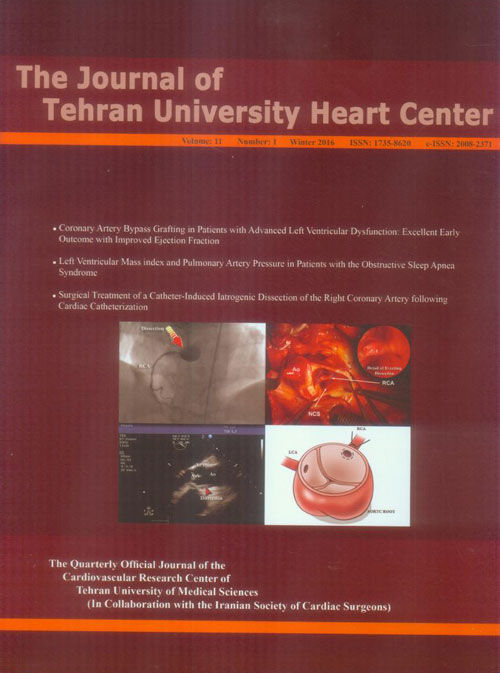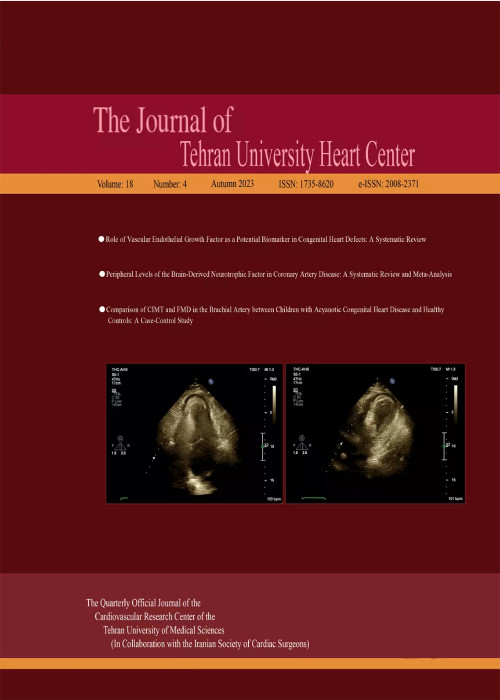فهرست مطالب

The Journal of Tehran University Heart Center
Volume:11 Issue: 1, Jan 2016
- تاریخ انتشار: 1395/01/08
- تعداد عناوین: 10
-
-
Pages 1-5Heart failure (HF) is still a major problem worldwide with high morbidity and mortality rates. The recently developed medication for HF is still incapable of reducing its morbidity and mortality, and clinical data supporting the efficacy and safety of its mainstay therapy remain insufficient.
Arginine-vasopressin (AVP) plays important roles in circulatory and water homeostasis, one of which is water retention through the V2 receptor. In patients with HF, there is an increased level of AVP, contributing to such symptoms as edema, dyspnea, and congestion. Tolvaptan as a selective V2 receptor antagonist, in addition to the conventional therapy, has been shown to cause an increase in net fluid loss, a decrease in body weight, and a reduction in the rate of HF exacerbation. Such evidence has been provided by the Acute and Chronic Therapeutic Impact of a Vasopressin Antagonist (ACTIV) in Congestive Heart Failure (CHF), Efficacy of Vasopressin Antagonism in Heart Failure Outcome Study With Tolvaptan (EVEREST), Acute Heart Failure Volume Control Multicenter Randomized (AVCMA), and Study of Ascending Levels of Tolvaptan in hyponatremia 1and 2 (SALT-1 and SALT-2) trials. Tolvaptan can be an alternative diuretic in conjunction with other standard therapies for HF and has already been proved to be able to decrease morbidity and mortality, especially in HF patients with hyponatremia.Keywords: Heart failure, Arginine vasopressin, Tolvaptan, Drug therapy -
Pages 6-10BackgroundThe prevalence of patients with severe left ventricular dysfunction (LVD) referred for coronary artery bypass grafting (CABG) is increasing. Preoperative LVD is an established risk factor for early and late mortality after revascularization. The aim of the present study was to assess the early outcome of patients with severe LVD undergoing CABG.MethodsBetween December 2012 and November 2014, 145 consecutive patients with severely impaired LV function (ejection fraction ≤ 30%) undergoing either on-pump or off-pump CABG were enrolled. The primary end point was all-cause mortality. Different variables (preoperative, intraoperative, and postoperative) were evaluated and compared.ResultsThe mean age of the patients was 58.7 years (range, 34 to 87 years), and 82.8% of the patients were male. The mean preoperative LV ejection fraction was 25.33 ± 5.07% (10 to 30%), which improved to 26.67 ± 5.38% (10 to 40%) (p valueConclusionCABG in patients with severe LVD can be performed with low mortality. CABG can be considered a safe and effective therapy for patients with a low ejection fraction who have ischemic heart disease and predominance of tissue viability.Keywords: Coronary artery bypass, Ventricular dysfunction, left, Myocardial revascularization
-
Pages 11-14BackgroundSleep apnea is accompanied by some cardiovascular complications. It has even been hypothesized that sleep apnea, itself, can induce some of these complications. Given such controversies, we assessed the left ventricular mass index (LVMI) and systolic pulmonary artery pressure in patients with sleep apnea.MethodsThrough convenience sampling, 56 patients with the obstructive sleep apnea syndrome (OSAS) were included in the present descriptive cross-sectional study. Patients with any past history of hypertension and diabetes mellitus were excluded. The apnea severity was assessed via the polysomnography-derived apnea-hypopnea index (AHI). All the patients underwent transthoracic echocardiography. In this cross-sectional study - data regarding age, gender, smoking, systolic and diastolic blood pressures, polysomnographic parameters (AHI, severity of disease, mean heart rate, mean oxygen saturation [SaO2], lowest SaO2, and duration of SaO2 below 90% [d.SaO2ResultsFifty-two men and 14 women at a mean age of 49.29 ± 11.79 years participated in this study. Systolic and was significantly high in the severe group compared with the mild group (128.21 ± 9.73 mmHg vs. 119.23 ± 12.5 mmHg; p value = 0.007). The LVMI was increased parallel to an increase in the severity of the OSAS, but that increase was not statistically significant (p value = 0.161). The d.SaO2ConclusionSevere OSAS was accompanied by a higher blood pressure. The LVMI did not differ significantly between the patients with the OSAS and those who did not suffer from other risk factors of cardiac diseases.Keywords: Sleep apnea, obstructive, Heart ventricles, Pulmonary artery
-
Pages 15-20BackgroundVarious studies have indicated that dyslipidemia starts in childhood. There is a relationship between the concentration of blood lipids and atherosclerosis. In this study, we assessed the prevalence of dyslipidemia in elementary school children.MethodsThis cross-sectional study was performed on 1,626 (882 girls and 744 boys) elementary school children aged between 6 and 11 years in Birjand in 2012. Samples were selected through multistage random sampling. The lipid profiles (i.e., cholesterol, triglyceride, high-density lipoprotein cholesterol [HDL-C], low-density lipoprotein cholesterol [LDL-C]) of the subjects were measured after 12 hours fasting. The definition of dyslipidemia was based on the criteria of The American Children Academia in 2011.ResultsDyslipidemia (at least one abnormal level of a serum lipid) was detected in 31% of the children (31.3% of the girls vs. 30.6% of the boys). Total cholesterol was ≥ 200 mg/dL in 13.4% of the children, LDL-C was ≥ 130 mg/dL in 8.5%, HDL-C wasConclusionThe prevalence of dyslipidemia was high in the school children in Birjand and, thus, requires preventive measures.Keywords: Dyslipidemias, Child, Prevalence, Iran
-
Pages 21-29BackgroundDietary risk factors constitute some of the leading risk factors for cardiovascular disease in Iran. The current study reports the burden of ischemic heart disease (IHD) attributable to a low omega-3 fatty acids intake in Iran using the data of the Global Burden of Disease (GBD) Study 2010.MethodsWe used data on Iran for the years 1990, 2005, and 2010 derived from the GBD Study conducted by the Institute for Health Metrics and Evaluation (IHME) in 2010. Using the comparative risk assessment, we calculated the proportion of death, years of life lost, years lived with disability, and disability-adjusted life years (DALYs) caused by IHD attributable to a low omega-3 fatty acids intake in the GBD studies from 1990 to 2010.ResultsIn 1990, a dietary pattern low in seafood omega-3 fatty acids intake was responsible for 423 (95% uncertainty interval [UI], 300 to 559), 3000 (95% UI, 2182 to 3840), and 4743 (95% UI, 3280 to 6047) DALYs per 100000 persons in the age groups of 15 to 49 years, 50 to 69 years, and 70 years respectively in both sexes. The DALY rates decreased to 250 (95% UI, 172 to 331), 2078 (95% UI, 1446 to 2729), and 3911 (95% UI, 2736 to 5142) in 2010. The death rates per 100000 persons in the mentioned age groups were 9 (95% UI, 6 to 12), 113 (95% UI, 82 to 144), and 366 (95% UI, 255 to 469) in 1990 versus 6 (95% UI, 4 to 7), 76 (95% UI, 53 to 99), and 344 (95% UI, 241 to 453) in 2010. The burden of IHD attributable to diet low in seafood omega-3 was 1.3% (95% UI, 0.97 to 1.7) of the total DALYs in 1990 and 2.0% (95% UI, 1.45 to 2.63) in 2010 for Iran.ConclusionThe findings of the GBD Study 2010 showed a declining trend in the burden of IHD attributable to a low omega-3 fatty acids intake in a period of 20 years. Additional disease burden studies at national and sub-national levels in Iran using more data sources are suggested for public health priorities and planning public health strategies.Keywords: Cardiovascular diseases, Myocardial ischemia, Fatty acid, omega, 3, Cost of illness, Iran
-
Pages 30-33Iatrogenic dissections of the ascending aorta are an uncommon and severe complication during cardiac catheterization. A 68-year-old female patient underwent diagnostic cardiac catheterization due to non-ST-elevation myocardial infarction. During the procedure, a catheter-induced 360 Class I dissection of the right coronary artery occurred. The patient developed severe bradycardia, which was treated with a temporary pacemaker. She underwent an emergency operation with ligation and a saphenous vein graft in the right coronary artery. The postoperative course was uneventful; and on postoperative day 6, she was discharged home.Keywords: Cardiac catheterization, Dissection, Iatrogenic disease
-
Pages 34-37Dissection of the sinus of Valsalva is a rare and life-threatening event. It often occurs during percutaneous coronary intervention in the right coronary artery (RCA). Dissection flap usually involves the RCA and the right sinus of Valsalva. Here we report two extremely rare cases of spontaneous dissection limited to the non-coronary sinus of Valsalva, causing severe aortic valve regurgitation: a male aged 51 years presenting with back pain, weakness, and presyncope and another male aged 71 years presenting with orthopnea and weakness. The dissection was found by transesophageal echocardiography. Surgical treatment was successful for both patients.
One year after surgery, both patients were asymptomatic and follow- up transthoracic echocardiography did not show any abnormality.Keywords: Aorta, Dissection, Aortic valve insufficiency, Sinus of Valsalva, Echocardiography, transesophageal -
Pages 38-40Acute fulminant myocarditis is a life-threatening inflammatory disease of the myocardium characterized by the rapid deterioration of the hemodynamic status of the affected individual. With prompt recognition and appropriate management, complete recovery of ventricular function is likely within a few weeks. We introduce a 28-year-old man with acute fulminant myocarditis, who experienced circulatory collapse following acute angina and dyspnea. The patient had high troponin levels with low ejection fraction and normal coronary arteries. He was successfully bridged to recovery with a left ventricular assist device but was complicated by flail mitral valve. Perioperative myocardial biopsy was also compatible with myocarditis. At 4 months follow-up, the patient was stable with functional capacity I according to the New York Heart Associations classification. A possible mechanism for this very rare complication is the rupture of the chordal structure secondary to the fragility of an inflamed subvalvular apparatus stretched by a recovered ventricle.Keywords: Myocarditis, Heart, assist devices, Mitral valve
-
Pages 41-45Aneurysms of the left main coronary artery are exceedingly rare clinical entities, encountered incidentally in approximately 0.1% of patients who undergo routine angiography. The most common cause of coronary artery aneurysms is atherosclerosis. Angiography is the gold standard for diagnosis and treatment. Depending on the severity of the coexisting coronary stenosis, patients with left main coronary artery aneurysms can be effectively managed either surgically or pharmacologically. We herein report a case of left main coronary artery aneurysm in a 72-year-old man with a prior history of hypertension presenting to our hospital because of unstable angina. The electrocardiogram showed ST-segment depression and T-wave inversion in the precordial leads. All the data of blood chemistry were normal. Echocardiography showed akinetic anterior wall, septum, and apex, mild mitral regurgitation and ejection fraction of 45%. Coronary angiography revealed a saccular aneurysm of the left main coronary artery with significant stenosis in the left anterior descending, left circumflex, and right coronary artery. The patient immediately underwent coronary artery bypass grafting and ligation of the aneurysm. At six months follow-up, he remained asymptomatic.Keywords: Coronary vessels, Coronary angiography, Aneurysm


